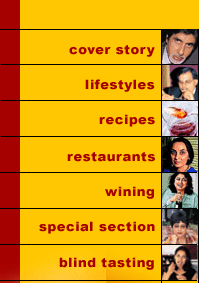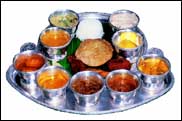



|
|
TRADITIONAL Bengali cuisine was centred around rice. None the less, rice was not the principal item in the savoury part of a Bengali meal. It was eaten and had to be eaten with a number of accompaniments, without which even one course would not be complete. In a family meal, rice would be eaten with at least four other savoury dishes, but in a formal meal the accompaniments would run even to seven, excluding the sweet courses.
But rice as a component in a meal of many dishes was not a mere filler. It had to be cooked with extreme care and skill, so that it would have a texture and a flavour of its own. Next, the rice, when put on the plate, had to be quite hot like the Muslim's roti. In that state it could not be eaten without scalding the tongue. So, the mistress of the house, i.e., the wife, sat before her husband with a hand fan and cooled the morsel for the husband.
The accompaniments to the rice had to be served in a definite order, and if they were not served in separate small bowls they had to be served one by one and not at the same time dumped, in all their variety, on the plate.
The order was as follows: first, a bitter dish called sukta or suktani as an aperitif; after that came one or more vegetable dishes; this was followed by one or more dal, with the accompaniment of fried vegetables or fried fish; then came two fish courses, one sharp with mustard and the other more or less bland; meat, almost always tender male kid (female kid was forbidden to a Hindu, and an uncastrated male kid to a Muslim) would then be served, to be eaten with rice pilau, or luchi (phulka done in ghee); the savoury part of the meal would wind up with a sour-sweet dish, called chutney or tak or ambal.
The specialities of Bengali cooking were, first, the vegetables and after that the fish. Fish was the main item in a daily meal for all others and therefore it was also cooked with care and variety. There were certain fishes which had to be eaten caught very fresh. So, only those who lived on the banks of the river in which each fish was found could eat it at its best.
For instance, the hilsa, although found in inland waters, was really an estuarial fish, and therefore it was best in Calcutta or on the banks of Hooghly to the town of Hooghly. The famous mango fish was also found only in the Hooghly river. It was bought usually in the morning and served at lunch. About seven of them, fried golden brown, made one helping.
In regard to the rohit and its relatives (i.e. of the carp family), which were highly prized by all Bengalis, there was a difference both in the choice and cooking between West and East Bengal. The West Bengal Bengali preferred the fish bred in the tanks (pukurer pona), while East Bengal Bengalis, for choice, ate those which came form the big rivers. Therefore this fish was taken to the villages inland in very fast boats.
With traditional Bengali cuisine, what it added to the raw materials of cooking enhanced the flavour of those ingredients but never suppressed either their character or their special qualities. I shall try to illustrate the result of the Bengali traditional cuisine by giving the example of the sweets, for which Bengal was famous. They were, of course, made in various grades and qualities, some for common people, and some for fastidious gourmets. The sweets for popular consumption were sweet to the point of being not only cloying but coarse. But in the higher grades they were just sweet.
The most famous Bengali sweets are, of course, sandesh and rassogolla. But there are many other offshoots of these. All of these are made from the casein of milk, called chhana in Bengali and taza panir in Hindi. The casein is mixed with sugar, and then made into sweets in different ways. All are given fanciful names.
To give just one example: it is now forgotten that the sweet which now commonly passes under the name of gulab jamun or jamun was called ledikeni in Calcutta. That name was simply a transformation of the name of Lady Canning, wife of the first Viceroy of India, in whose honour the sweet was invented. Certain towns and villages in Bengal were also famous for their special sweets: e.g., Burdwan for its mihidana and sitabhog, Janai for its monohora, Molnai for its gollah, Rishra for its gaja.
|

Home Page
About the mag
Subscribe
Advertise
Contact Us